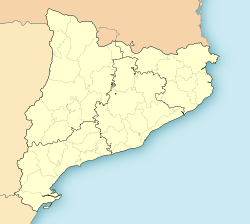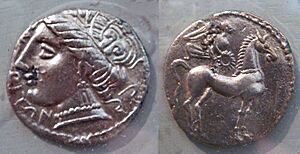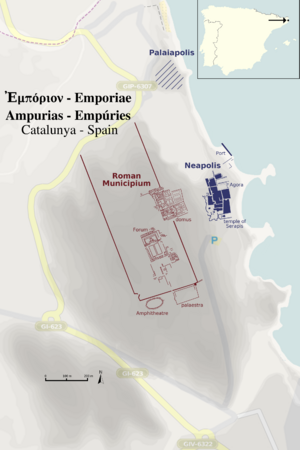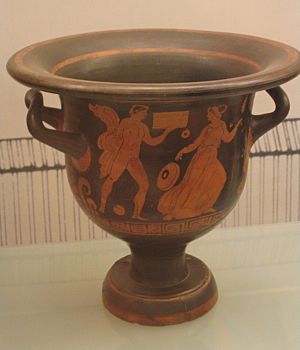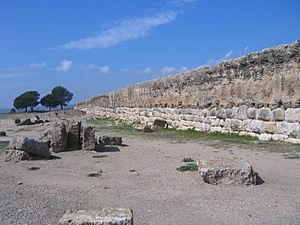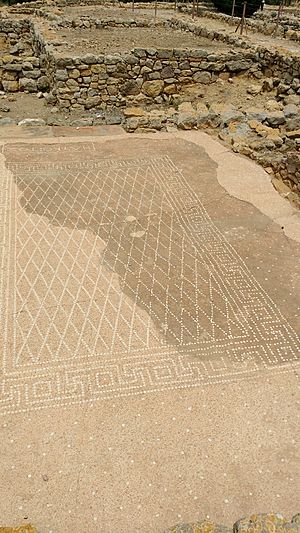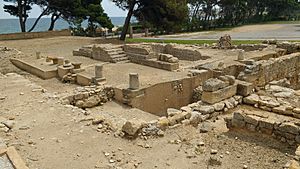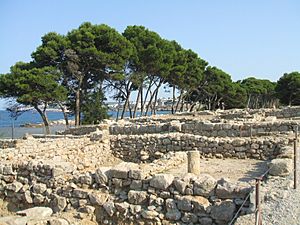Empúries facts for kids
|
Empúries
Ampurias Ἐμπόριον Emporiae |
|
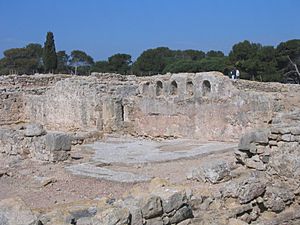
Palaeochristian basilica at Empúries
|
|
| Alternative name | Ampurias |
|---|---|
| Location | Alt Empordà, Province of Girona, Catalonia, Spain |
| Coordinates | 42°08′05″N 03°07′14″E / 42.13472°N 3.12056°E |
| Type | Settlement |
| History | |
| Builder | Colonists from Phocaea |
| Founded | 575 BC |
| Periods | Archaic Greek to Early Medieval |
Empúries (also known as Ampurias) was an ancient city right on the Mediterranean coast in Catalonia, Spain. Its name, Ἐμπόριον (Emporion), means "trading place" in ancient Greek.
Greek settlers from a city called Phocaea founded Empúries in 575 BC. Later, in 218 BC, the Romans took over the city. This happened after the Carthaginian general Hannibal invaded Gaul from Iberia. Over time, especially in the Early Middle Ages, the city was left open to attacks from the sea. Because of this, people eventually abandoned it.
Today, the ruins of Empúries are found in the Alt Empordà region of Costa Brava. They are located between the town of L'Escala and the small village of Sant Martí d'Empúries.
Contents
A Look at Empúries' Past
Empúries was first built on a small island at the mouth of the Fluvià river. This area was home to a local group of people called the Indigetes. This first settlement became known as the Palaiapolis, meaning "old city."
Around 550 BC, the people moved to the mainland. Here, they built a new city called the Neapolis, or "new city."
When the Persian king Cyrus II conquered Phocaea in 530 BC, many refugees came to Empúries. This made the new city's population grow a lot. Even with strong pressure from Carthage, Empúries managed to stay independent and Greek.
The city made trade deals with the local people living in nearby Indika. Empúries was on an important trade route between Massalia (Marseille) and Tartessos in southern Hispania. This helped it become a major center for trade and the largest Greek colony in the Iberian Peninsula.
Empúries and the Romans
During the Punic Wars, Empúries became an ally of Rome. In 218 BC, the Roman general Publius Cornelius Scipio began his conquest of Hispania from this very city. He sent his brother Gnaeus Cornelius Scipio Calvus and Roman troops there.
Even after the Romans conquered Hispania, Empúries remained an independent city-state. However, during a civil war between Pompey and Julius Caesar, Empúries supported Pompey. After Pompey's defeat, Empúries lost its independence. The Romans then built a new settlement, a colonia, for Roman soldiers near Indika to control the area.
From this point on, Empúries started to become less important. Other powerful Roman cities like Tarraco (Tarragona) and Barcino (Barcelona) grew larger. By the end of the 3rd century, Empúries was one of the first cities in Spain to welcome Christian teachers. The Greek town was abandoned, but the Roman town continued to exist. It was a place where coins were made and served as the main town for a coastal area until Viking raids in the mid-9th century.
Exploring the Ancient Ruins
People have known where Empúries was since the 1400s. But serious archaeological digs only began in the 20th century. The first official excavations started in 1908. They were led by Emili Gandia i Ortega under the guidance of Josep Puig i Cadafalch and Pere Bosch-Gimpera. These excavations are still happening today!
The Old City: Palaiapolis
The island where the Palaiapolis was located is now part of the mainland. It's where the medieval village of Sant Martí d'Empúries stands today. The old harbor has also filled up with sand and dirt over time. Not much excavation has been done in this area.
After the Neapolis was built, the old city likely became a fortress and a place for temples. Ancient writers mention a temple dedicated to the goddess Artemis here.
The New City: Neapolis
The Neapolis was a walled area, about 200 by 130 meters in size. Its walls were built and changed many times between the 5th and 2nd centuries BC. To the west, the wall separated the Neapolis from the Iberian town of Indika.
In the southwest part of the city, there were several temples. One important temple was for Asclepius, the god of healing. A marble statue of him was found here. In the southeast, there was a temple for Zeus-Serapis. Most of the buildings found belong to the Hellenistic period (when Greek culture spread widely).
Archaeologists have found houses, some with beautiful mosaics and wall paintings. They also found public buildings in the agora (a public open space) and a harbor mole (a pier or breakwater). Later, during the Roman period, thermae (bathhouses) and an early Christian basilica were built.
To the south and east of the new city was an area used as a necropolis (a large ancient cemetery).
The Roman City
Only about 20% of the Roman city has been dug up. This city had the typical Roman layout, like a military camp. It had two main roads that met at the forum, which was the public square. The Roman city was much larger than the Greek one.
During the Republican period, a temple was built for the Capitoline Triad: Jupiter, Juno, and Minerva. When Emperor Augustus ruled, a basilica and a curia (a meeting hall) were added.
In the eastern part of the Roman town, archaeologists found large houses. These homes had inner courtyards, many extra rooms, floor mosaics, and paintings. In the 2nd century AD, the town was surrounded by a wall without towers. An amphitheatre (for public shows) and a palaestra (a wrestling school or exercise ground) were built outside the wall.
Ancient Burial Grounds
The burial grounds of Empúries were used for a very long time, from the 7th century BC until the Middle Ages. Sadly, many tombs were robbed over the centuries. There are four main types of burials found: early Greek and Iberian, late Republican, early Roman Empire, and late Roman Empire.
Early Greeks and Iberians (6th–3rd century BC)
Burials were found on the southern and western sides of the Neapolis. Most Greek burials involved burying the body (inhumation). About a third of the burials were cremations (burning the body), which was common for the Iberians.
Late Republican (2nd–1st century BC)
The old burial grounds continued to be used for both inhumations and cremations. Another group of burials, likely Roman, used cremation more often. Their cemetery was on the north side of a nearby hill. Archaeologists found small mounds made of stone blocks with the remains of cremations inside.
Early Roman Empire (1st century BC – 2nd century AD)
For about 35 years, from the mid-1st century BC to the reign of Augustus, no clear burials have been found. After that, cremation burials were common until the end of the 1st century AD. These were found around the hillside where the Roman city is located.
In the 2nd century AD, burial customs changed, and only inhumations (burials of bodies) have been found.
Late Roman Empire (3rd – 6th century)
It's hard to know the exact dates for these tombs because they often didn't have many items buried with them. The entire area of the ancient Greek city became filled with inhumation burials. These might be connected to the early Christian basilica or a special memorial building located there. Burials were also found in many older cemeteries and new ones.
The Archaeology Museum of Catalonia
The Archaeology Museum of Catalonia has a branch right at Empúries (MAC-Empúries). This museum lets visitors see the archaeological remains up close. You can explore the Greek city and the Roman city. Then, you can visit the museum to see important objects found during years of excavations at Empúries. The museum has parking, and you can walk to the site along a traffic-free coastal path from L'Escala.
See also
 In Spanish: Ampurias para niños
In Spanish: Ampurias para niños
- List of ancient Greek cities
- List of traditional Greek place names
Images for kids



